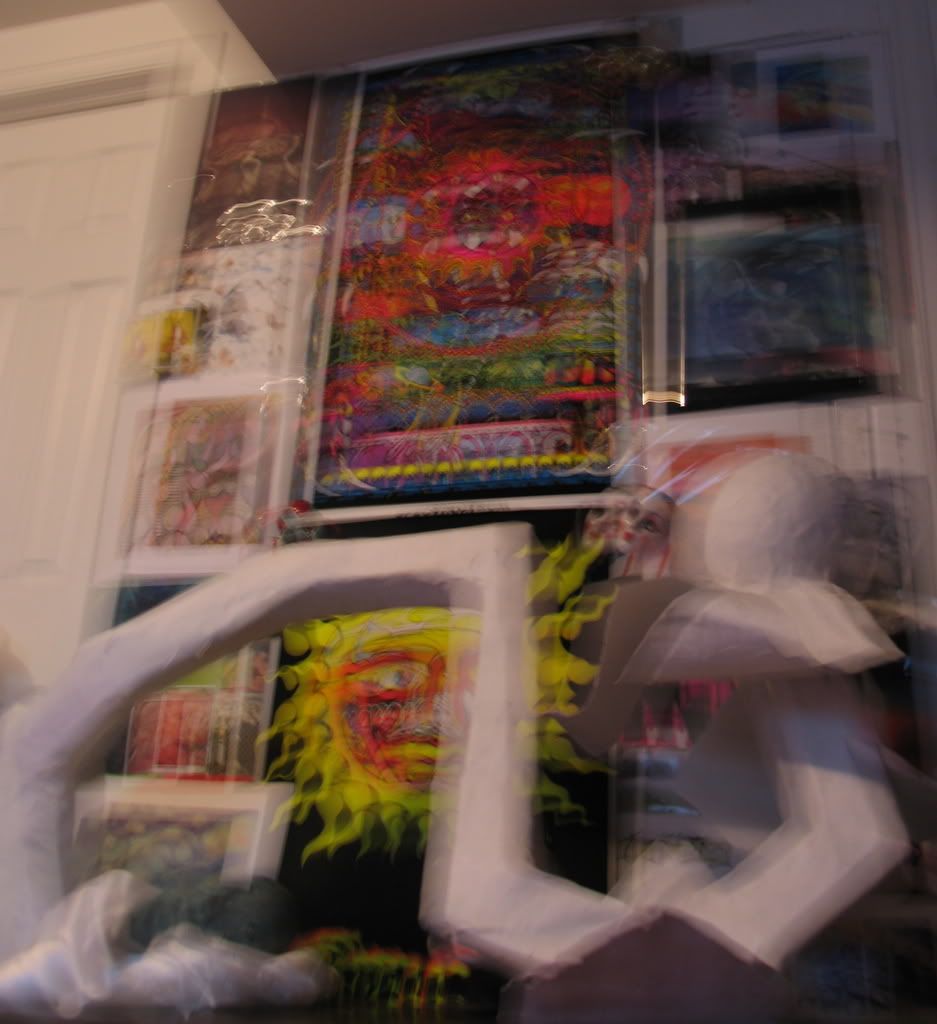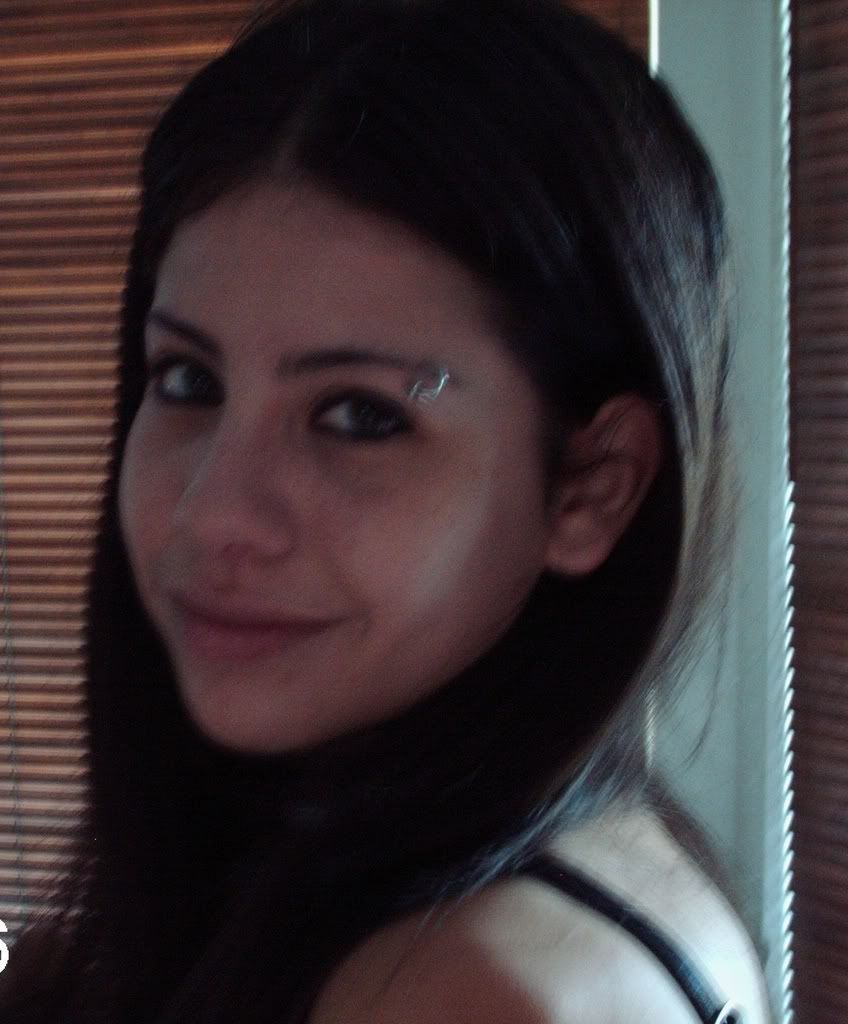
Nothing is as it appears to be, through a trick of the camera the artist has provided a different perspective on a piece of art; for it is distorted and collective at the same time. This is not just a beautiful image it is a room with a distinct view of being shaken up; the image does not appear to be moving but the room itself. This form of art is very interesting; to take a room and form it into something beautiful that changes ones perspective.To take a room and mold it beyond a normal room is done to make a statement about the whole within an abstract form.
The art form that is used within the photograph is a form of installation art. The real focus of the photograph is the technique used by the photographer. The technique is what gives this photograph a unique perspective and allows the viewer to understand the meaning of the artist. “Combining the action-stopping effect of the strobe with a relatively long available-light exposure leaves ghosting around the riders and imparts a sense of action to this bike race photo”. (Kobre pp.127) The technique used in this photograph is commonly used to enhance or create action and motion within an image. A shot that turns out to display this motion is usually not purposely conscious by the photographer but are accidentally found between images. In other words this image is a happy accident which displays action within the image.
.jpg)
(Photo By: Dave Eulitt)
The camera angle is very important in achieving an interesting affect of these images. The majority of the images on the wall are out of focus. The camera appears to be moving, shaking up the wall making it appear as though it had never been still. By having this affect there is a point of view that nothing is as it appears to be, the room looks as if it is moving not the camera. This is the point though; to take an unorthodox room and to make it as though someone came in and distorted the room.
The placement of the individual pieces of art on the wall add to the overall affect of the image. Pieces of artwork are not just randomly displayed for they are set up to tell a story; to be a continuous collective whole. The pieces placed on the wall are only a backdrop. This is not meaning that they do not have a large impact on the overall meaning of this piece of art. Regardless of the sculpture the individual pieces of art have a statement all to their own. They are more unfocused than anything else in the image. Having them ask a question of what is art. Are the images in the backdrop beautiful or does it appear to be because they are placed within another piece of art.
The main focus of this piece of art is the white sculpture that can be seen in the lower half the image. The sculpture is not on the wall as all the other images are. The color contrast of the white compared to the brightly colored wall puts emphasis on the white sculpture. Once again the camera angle plays a large role in emphasizing what the artist wants to be emphasized. The angle of this picture was taken right in front of the dying flower elongating and focusing on the sculpture. If the angle of the camera was different then it would change the sculpture being the first thing seen and would change the point of view of this image making it appear to be completely different.
A door can be seen in the background which is very important because elements such as the door, the light switch and the ceiling bring the viewer back to tell them that this is a room. The elements set the mood giving a small hint to of where the image takes place. If you cannot see the small details then the image change from a room to a wall that could be anywhere. This says something about the artist, it shows that this image is not just random and it would take away from the meaning of the image to have the setting be in any random place.
The distortion within the image has an effect which leads the viewer to realize that something is not right and does not appear to be correct. The distortion of the image through the camera is what causes the viewer to realize that something is not as appears to be. Logos and pathos are seen within this image for the same reason but they are both looking at the statement through two different approaches. Logos can be seen due to the fact that the reasonable thought one would have when viewing something distorted is that something is not right; the image is not as it would normally appear. Pathos appears because the emotion connected with distortion is being unsure of what is really there.
The collective whole of the room is not what one would think of when picturing a room or even an image of a room. The wall is covered in images that could appear to be random,it is a large white sculpture that seems to be dying, the room being shaken makes one question if it was ever still. The image almost appears not to be right for this scene and due to the camera angle there is distortion. Also in contrast are the ideas not just the images. Not only in ideas also within perspectives; is it rare to find something that is both whole and at the same time distorted (falling apart). There are many things that are not as they appear within different mediums of art, and in everyday life; it is important to realize where distortions are and the affects they have on a person.
Source sited: Kobre, Kenneth. Photo Journalism The Professionals Approach. San Francisco: Heinemann, 2000.
The placement of the individual pieces of art on the wall add to the overall affect of the image. Pieces of artwork are not just randomly displayed for they are set up to tell a story; to be a continuous collective whole. The pieces placed on the wall are only a backdrop. This is not meaning that they do not have a large impact on the overall meaning of this piece of art. Regardless of the sculpture the individual pieces of art have a statement all to their own. They are more unfocused than anything else in the image. Having them ask a question of what is art. Are the images in the backdrop beautiful or does it appear to be because they are placed within another piece of art.
The main focus of this piece of art is the white sculpture that can be seen in the lower half the image. The sculpture is not on the wall as all the other images are. The color contrast of the white compared to the brightly colored wall puts emphasis on the white sculpture. Once again the camera angle plays a large role in emphasizing what the artist wants to be emphasized. The angle of this picture was taken right in front of the dying flower elongating and focusing on the sculpture. If the angle of the camera was different then it would change the sculpture being the first thing seen and would change the point of view of this image making it appear to be completely different.
A door can be seen in the background which is very important because elements such as the door, the light switch and the ceiling bring the viewer back to tell them that this is a room. The elements set the mood giving a small hint to of where the image takes place. If you cannot see the small details then the image change from a room to a wall that could be anywhere. This says something about the artist, it shows that this image is not just random and it would take away from the meaning of the image to have the setting be in any random place.
The distortion within the image has an effect which leads the viewer to realize that something is not right and does not appear to be correct. The distortion of the image through the camera is what causes the viewer to realize that something is not as appears to be. Logos and pathos are seen within this image for the same reason but they are both looking at the statement through two different approaches. Logos can be seen due to the fact that the reasonable thought one would have when viewing something distorted is that something is not right; the image is not as it would normally appear. Pathos appears because the emotion connected with distortion is being unsure of what is really there.
The collective whole of the room is not what one would think of when picturing a room or even an image of a room. The wall is covered in images that could appear to be random,it is a large white sculpture that seems to be dying, the room being shaken makes one question if it was ever still. The image almost appears not to be right for this scene and due to the camera angle there is distortion. Also in contrast are the ideas not just the images. Not only in ideas also within perspectives; is it rare to find something that is both whole and at the same time distorted (falling apart). There are many things that are not as they appear within different mediums of art, and in everyday life; it is important to realize where distortions are and the affects they have on a person.
Source sited: Kobre, Kenneth. Photo Journalism The Professionals Approach. San Francisco: Heinemann, 2000.

No comments:
Post a Comment